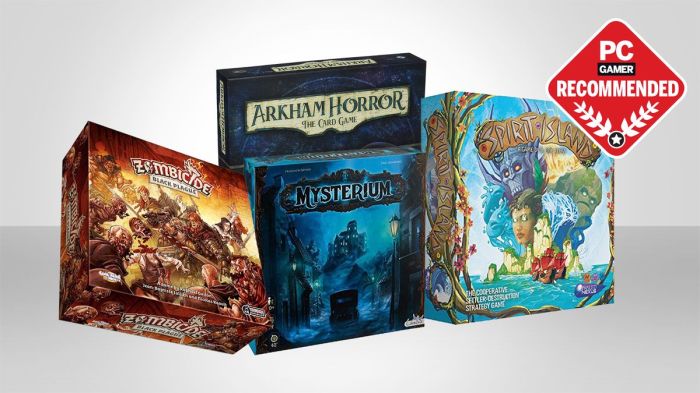
Cooperative board games redefine the way we engage with friends and family, creating opportunities for collaboration and strategy over competition. These games invite players to unite against common challenges, fostering a sense of camaraderie and shared achievement. Historically, cooperative board games have evolved from simple mechanics to complex narratives, reflecting the growing desire for social interaction in the gaming community.
Key features such as teamwork, shared goals, and player interdependence set them apart from their competitive counterparts, making them a unique and enriching gaming experience.
As we dive deeper into the world of cooperative board games, we will explore some of the most popular titles, their gameplay mechanics, and the themes that immerse players in their narratives. We’ll also examine the complexity levels of these games and identify their target audiences, ensuring that both casual gamers and seasoned strategists can find something that appeals to them.
Introduction to Cooperative Board Games
Cooperative board games have garnered significant attention and appreciation in the gaming community, offering players a unique experience that emphasizes collaboration rather than competition. In these games, participants work together to achieve a common goal, fostering teamwork and strategic thinking. The essence of cooperative games lies in their ability to create a shared narrative and a sense of community among players, setting them apart from traditional competitive formats.The history of cooperative board games can be traced back several decades, with roots in the desire for shared experiences rather than adversarial play.
Early examples include games like “Pandemic,” released in 2008, which introduced complex strategies and required players to combine their strengths to overcome challenges. Over the years, the genre has evolved significantly, incorporating diverse themes and mechanics, making cooperative games increasingly popular. Titles such as “Ghost Stories” and “Gloomhaven” have expanded the genre, showcasing intricate designs and deeper storytelling.
Key Characteristics of Cooperative Board Games
Cooperative board games possess distinct features that differentiate them from their competitive counterparts. Understanding these characteristics enhances appreciation for the genre and its appeal to various player demographics. The following points highlight the essential traits:
- Shared Objectives: Players unite towards a common goal, often battling against the game itself rather than each other. This fosters a collaborative spirit among participants.
- Role Specialization: Many cooperative games allow players to take on unique roles or characters, each possessing individual abilities and strengths that contribute to the team’s success.
- Adaptive Challenges: The game mechanics often adjust in response to player actions, ensuring that the gameplay remains dynamic and engaging, which encourages strategic planning and teamwork.
- Encouragement of Discussion: These games generally promote communication among players, as discussing strategies and sharing ideas is crucial to overcoming obstacles.
- Inclusive Experience: Cooperative board games cater to diverse player skill levels, making them accessible to beginners while still offering depth for seasoned gamers seeking strategic gameplay.
“The essence of cooperative games lies in their ability to create a shared narrative and a sense of community among players.”
The combination of these characteristics leads to engaging gameplay that not only entertains but also strengthens social bonds and enhances the gaming experience.
Popular Cooperative Board Games
Cooperative board games have surged in popularity, providing engaging experiences that encourage teamwork and strategic thinking. Players unite against common challenges, enhancing social interaction and building camaraderie. This section will delve into some of the most celebrated cooperative board games available today, along with their gameplay mechanics, themes, narratives, and complexity levels.
Top Cooperative Board Games
A variety of cooperative board games cater to different tastes and preferences, featuring unique gameplay mechanics that create immersive experiences. The following list highlights some of the most popular options:
- Pandemic: Players work together as members of a disease control team, strategizing to stop the spread of infections across the globe. Players must manage their resources effectively, travel to affected areas, and develop cures within a race against time.
- Gloomhaven: This campaign-driven game combines tactical combat and exploration in a fantasy setting. Players assume the roles of mercenaries, undertaking quests and battling enemies while developing their characters and making impactful choices that influence the ongoing narrative.
- Spirit Island: Players take on the roles of powerful spirits defending their island from colonizing invaders. This game emphasizes strategy and synergy, as players use unique abilities to manipulate the board and fend off threats while coordinating their actions for maximum impact.
- Forbidden Island: A family-friendly game where players must retrieve treasures from a sinking island. Quick decision-making and teamwork are essential, as players navigate a constantly changing board and work together to escape before the island is fully submerged.
- Ghost Stories: Set in a haunted village, players work as Taoist monks defending their community from vengeful spirits. The cooperative gameplay involves strategic use of unique monk powers to fend off ghosts while managing the increasing chaos in the village.
Themes and Narratives in Cooperative Board Games
Cooperative board games often explore diverse themes and narratives that enhance gameplay and engage players on a deeper level. These themes range from historical events to fantastical adventures, creating rich stories that unfold as players progress through the game. Notable themes include:
- Apocalyptic Scenarios
- Fantasy and Adventure: Titles such as Gloomhaven and Spirit Island transport players to rich worlds filled with mythical creatures and epic quests, encouraging teamwork and strategic planning.
- Historical Context: Some games, such as Freedom: The Underground Railroad, explore significant historical events, enabling players to engage with profound narratives and learn about past struggles for freedom and justice.
- Mystery and Investigation: In games like Sherlock Holmes: Consulting Detective, players collaborate to solve crimes and unravel mysteries, highlighting critical thinking and deductive reasoning.
Complexity Levels and Target Audiences
Cooperative board games vary significantly in complexity, appealing to a broad audience ranging from casual gamers to seasoned strategists. Understanding the complexity levels helps players choose games that match their experience and preferences.
- Beginner-Friendly: Games like Forbidden Island and Pandemic are accessible to new players, featuring straightforward rules and shorter gameplay durations, making them perfect for family game nights or casual gatherings.
- Intermediate Complexity: Titles such as Ghost Stories and Spirit Island introduce more intricate mechanics and strategies, catering to players who enjoy a moderate challenge while still promoting collaboration.
- Advanced Strategy: Gloomhaven and other complex titles demand deep strategic thinking, extensive planning, and often lengthy play sessions. These games are designed for dedicated gamers who appreciate rich narratives and character development.
Cooperative board games foster social connections and create shared experiences, making them an ideal choice for players looking to bond while tackling challenges together.
Exploring Related Genres

Cooperative gameplay extends beyond traditional board games, weaving through various genres and platforms. This exploration reveals the intricate connections and distinctions between cooperative experiences, whether they manifest in board games, card games, arcade games, video games, or role-playing games. Understanding these relationships enriches our appreciation for cooperative play and its diverse applications.
Similarities and Differences Between Cooperative Board Games and Card Games
Cooperative board games and card games share a fundamental principle: players collaborate to achieve a common objective, promoting interaction and teamwork. They both often rely on strategic elements and require players to communicate effectively to succeed. However, they differ in their mechanics and presentation. Board games typically feature a larger physical setup, often including a game board, player pieces, and various components that shape the gameplay experience.
In contrast, card games are more portable, relying heavily on card mechanics, which can lead to quicker rounds and simpler setups.
Cooperative games thrive on player interaction, yet the medium shapes their dynamics.
The differences can also be reflected in the complexity of gameplay. Board games may involve longer playing times and more complex rules, whereas card games tend to offer faster play sessions with streamlined mechanics. This distinction can influence player preferences, as some may enjoy the depth of board games, while others favor the accessibility of card games.
Cooperative Elements in Arcade and Coin-Op Games
Arcade and coin-op games have historically embraced cooperative gameplay, allowing players to team up to tackle challenges. These games often incorporate cooperative elements by enabling players to share resources, work together against AI opponents, or compete for high scores as a unified team. Classic examples include beat ’em ups like “Teenage Mutant Ninja Turtles” and “The Simpsons Arcade Game,” where players join forces to defeat waves of enemies and bosses.The cooperative aspect in arcade gaming enhances social interaction, as players often gather around the machine, cheering each other on.
The competition for high scores fosters a sense of camaraderie, turning individual achievements into shared victories. The coin-op model also encourages repeat play, as players return to improve their performance collectively.
Comparison of Cooperative Video Games and Traditional Board Games
Cooperative video games and traditional board games both emphasize teamwork and shared goals, yet they differ significantly in gameplay experience. Video games often feature dynamic environments, real-time actions, and immersive graphics that can enhance engagement. In contrast, board games rely on physical components and face-to-face interaction, which can foster a different type of social connection.The adaptability of video games allows for complex algorithms and mechanics that can change gameplay based on player actions.
For instance, games like “Left 4 Dead” dynamically adjust difficulty depending on team performance, creating unique experiences with each session. In board games, scenarios can be crafted in advance, allowing for strategic planning but generally offering a more static experience.
Video games provide a real-time experience, while board games emphasize strategic interaction.
Examples of cooperative video games like “Overcooked!” highlight the need for teamwork in fast-paced situations, contrasting with the slower-paced strategic planning found in cooperative board games like “Pandemic.”
Role-Playing Games Incorporating Cooperative Gameplay Mechanics
Role-playing games (RPGs) are known for their rich storytelling and character development, and they often incorporate cooperative gameplay mechanics to enhance the experience. In RPGs, players usually form a party, each taking on unique roles, strengths, and weaknesses that complement one another. This structure encourages collaboration as players strategize how to combine their skills effectively.Cooperative mechanics in RPGs can include shared resources, joint quests, and the necessity for teamwork in combat scenarios.
Games such as “Dungeons & Dragons” exemplify this by requiring players to work together to navigate challenges and story arcs, enhancing the overall narrative experience. The cooperative aspect deepens player investment as they develop relationships with their characters and fellow players.
Online Games Emphasizing Cooperative Play and Community Impact
The rise of online gaming has brought cooperative play to a broader audience, creating communities centered around teamwork and collaboration. Games like “Fortnite” and “World of Warcraft” foster social connections, allowing players to form guilds and clans that work together towards common goals. These communities often extend beyond the game, with players discussing strategies, organizing events, and forming friendships.The impact of cooperative online games can be seen in the development of social skills and community-building.
Players learn to communicate effectively, resolve conflicts, and develop trust in their teammates. Furthermore, successful cooperative experiences can lead to a sense of achievement and belonging, with players celebrating their victories together and supporting each other in challenges.
Online cooperative games forge connections that transcend the virtual world.
The capacity for cooperative online gameplay to impact community dynamics highlights the importance of teamwork, collaboration, and social interaction in the modern gaming landscape.
Wrap-Up

In conclusion, cooperative board games offer a refreshing alternative to traditional competitive games, emphasizing teamwork and community over rivalry. These games not only foster cooperative gameplay but also enhance social interaction, making them perfect for gatherings with friends or family. Whether you’re fighting against a dark force in a fantasy realm or solving a mystery as a team, the shared experiences are what make cooperative board games a staple in the modern gaming landscape.
Top FAQs
What are some key characteristics of cooperative board games?
Cooperative board games emphasize teamwork, shared objectives, and collaborative problem-solving, setting them apart from competitive games.
Can you play cooperative board games solo?
Yes, many cooperative board games offer solo play options, allowing players to experience the game independently.
How do cooperative board games benefit social interactions?
They promote collaboration, communication, and bonding among players, enhancing social experiences and teamwork skills.
Are cooperative board games suitable for children?
Absolutely! Many cooperative board games are designed specifically for children, teaching them teamwork and strategy in a fun way.
How do you win a cooperative board game?
Players win together by achieving the shared goals set by the game, often overcoming challenges presented throughout the gameplay.





